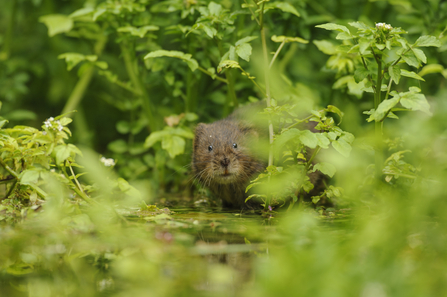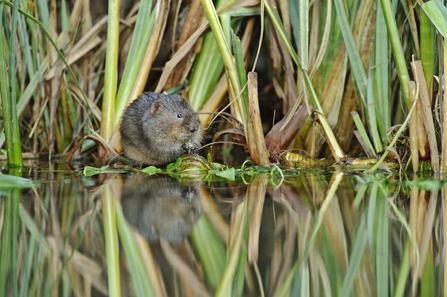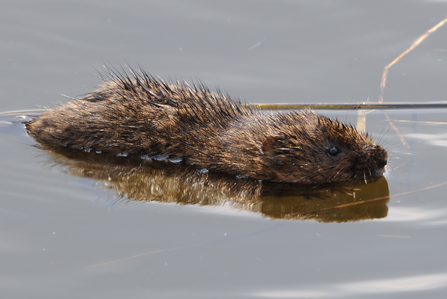
©Terry Whittaker/2020VISION

©Terry Whittaker/2020VISION
I began wandering along ditches, streams, rivers and lakes, looking for water vole field signs in 2004. My frequent visits were due to being told that they were in serious decline which had mainly been caused by habitat loss and predation by the non-native American mink. On learning about their plight, I passionately wanted to help these charismatic mammals.
As I looked intently at the banks and the water's edge for their distinctive feeding signs (water voles are herbivores), burrows, latrines or footprints, I began to notice over subsequent years that where water voles were present there was a greater diversity of plants growing on the banks. Also, the plants looked healthier due to the constant 'gardening' through nipping and grazing by water voles, compared to the lacklustre banksides where water voles were absent. This was especially noted along banks where more dominant species of grass were taking over and where I had seen these delightful mammals beavering away in previous years. Hence, one of the deserved names given by past generations to these delightful, chubby, bright-eyed voles is the British beaver. Prior to discovering this name, I had often referred to them as mini-beavers after finding willow stems up to inch in diameter which they had completely gnawed through on more than one occasion!

Terry Whittaker/2020VISION
By 2015, I began to be able to tell whether a riverbank or stream had a water vole colony by whether the plant community was diverse and thriving. I was cautious about whether this observation was right. Was it just wishful thinking? I checked to see if any research had been done which supported my findings and found this abstract written in 2006: The ecosystem engineering and trophic effects of the water vole: species loss and ecosystem processes by Rosalind L. Bryce, University of Aberdeen. It was heartening to read that her research had found:
“Greater past occupancy and more burrowing disturbance had occurred in more species rich patches. Time since patch abandonment was also an important factor influencing vegetation composition. Burrow systems were extensive and had a drying effect on the surrounding soil below ground. Burrowing also altered soil biological properties. Levels of microbial biomass and activity were enhanced in tunnel walls. ... the rapid decline of water voles in the UK will reduce habitat heterogenity and lead to greater abundance of dominant grass species, resulting in lower community diversity.”
Here was evidence that water voles were crucial to a thriving wetland ecosystem by providing flower rich bank habitat for insect species such as bumblebees, moths and butterflies who need nectar or pollen, or both, and who become food for insect-eating birds and bats. Also, water voles' complex underground structures, are widely utilised by a range of other small mammal species, reptiles, amphibians and insects as refugia. [I have observed a water shrew using an unused water vole burrow to raise her young.] They are also a known prey species of red foxes, polecats, otters, stoats, pike, golden eagles, marsh harriers and grey herons.'*
Water voles are a keystone species and when they are absent a riverbank is impoverished

Amy Lewis
These are vital reasons why water voles must be helped to return to the former wetlands that they once inhabited and reintroduced to places where habitat fragmentation is so great that they will be unable to cover the distance required to recolonise an area. There simply is not enough time for successful recovery to allow natural recolonisations to take place. Before water voles are reintroduced, mink control and habitat restoration is necessary, so that they can recolonise their former habitats. Unlike otters, a breeding female mink can enter a water vole's burrow and will eradicate a water vole colony in one breeding season. Water voles are a keystone species and when they are absent a riverbank is impoverished.
I recently learnt that the water vole population has declined by a further 30% following the results of the England and Wales Water Vole Database and Mapping Project – which is a national survey of water vole distribution run by The Wildlife Trusts. This revealed that their numbers have plummeted from 1.2 million in 2002 to around 100,000. They are teetering on the brink of extinction and are in crisis.
The return of the water vole is as important for our ponds, ditches, streams, rivers, lakes and wetlands as the reintroduction of the native beaver. Whereas the herbivorous beaver's ecosystem engineering of wetlands filters water, prevents flooding, and increases habitat for species such as otters, water voles, fish, bats, frogs, dragonflies and birds such as reed warblers to move in – the water vole will increase habitat for species such as insects, pollinators, small mammals, reptiles and amphibians.
A fully functioning wetland ecosystem is one which depends upon its native mammals engineering and managing the fabric of the land. Not only that, we depend on thriving, fully functioning ecosystems for our own survival. It takes humans many hours over a relatively small area to achieve the ecosystem engineering effect that a beaver family or water vole colony can achieve in a much shorter time-scale, because beavers and water voles are constantly engineering for the greater part of the year.
We have lost the deep connection to the earth that we used to have when we were hunter-gatherers and knowledge that we need to coexist with our wild, co-evolved, ecosystem managing kin, including beaver and lynx whom we hunted to extinction. We should be welcoming these species back and not letting water voles go the same way.
And finally, a Robert Burns poem to finish with:
To A Mouse
I’m truly sorry Man’s dominion
Has broken Nature’s social union,
An’ justifies that ill opinion,
Which makes thee startle,
At me, thy poor, earth-born companion,
An’ fellow mortal!
Robert Burns (1785)
* Reintroductions as an essential conservation tool for water vole populations. Article for Inside Ecology by Derek Gow https://insideecology.com/2018/01/09/reintroductions-as-an-essential-conservation-tool-for-water-vole-populations/